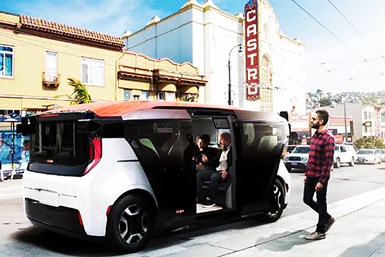GM's Cruise Hires Safety Chief
Louise Zhang, who previously worked for Lucid Motors and Tesla, underscores focus on safety as robo-taxi service nears launch
#regulations
Cruise, General Motors' self-driving subsidiary, has hired Louise Zhang as its first fulltime safety chief.

Louise Zhang (Image: Cruise)
Her appointment comes at a critical time for Cruise, which has struggled somewhat in the wake of COVID-19 and waning interest in autonomous vehicles. Last month, Cruise laid off about 8% of its employees.
But the company has a huge cash reserve and is moving forward with plans to debut a robo-taxi service, which originally was to launch last year. At the time of the layoffs, Cruise pledged to “double down on engineering work and engineering talent.”
EV Safety Experience
Zhang joins Cruise from Lucid Motors, where she most recently oversaw vehicle safety and regulatory compliance for the Silicon Valley-based electric vehicle startup.
Prior to joining Lucid in 2015, Zhang headed Tesla’s vehicle safety team. She also worked as an engineer at Delphi Automotive, leading safety system integration projects with Chinese automakers in Shanghai.

Cruise Origin
Zhang’s work at Delphi convinced her to pursue a career in vehicle safety. Noting that she quickly became fascinated by the technology and the social impact of such systems, Zhang says the experience defined her career and led her to focus on vehicle safety ever since.
Zhang has experience in crash accident data analysis, computer simulation, hardware and systems development and crash testing and validation.
What’s Next?
In January, Cruise unveiled the Origin electric shuttle, which GM co-developed with Honda. GM aims to manufacture the Origin at its revamped Detroit-Hamtramck factory in 2022.
The company also is working with GM to launch the Chevrolet Bolt-based robo-taxi program the companies have been developing for several years.
As vice president of product safety, Zhang will oversee validation capabilities and the development of new safety systems and best practices across hardware and software, according to Cruise.
In blog post on Medium, Zhang categorizes safety—for both autonomous and human-driven vehicles—into three groups: active, passive and post-crash systems (such as OnStar). All three must work together to be effective.
It’s clear where her focus is. "We will continue to advance all three of these areas in order to deliver the safest self-driving technology — you cannot have one without the other," Zhang writes. "But active safety is where I think we will see the most technical innovation in ensuring that AVs are better than human drivers."
RELATED CONTENT
-
When Automated Production Turning is the Low-Cost Option
For the right parts, or families of parts, an automated CNC turning cell is simply the least expensive way to produce high-quality parts. Here’s why.
-
We Can’t Unwatch this McLaren
While we generally can’t say enough (which brings us close to saying much, much too much) about McLaren Automotive design and its exquisite use of materials, this week the company launched a product that is something we wish we didn’t see: That’s the RM 11-03 McLaren Automatic Flyback Chronograph, which the company debuted at the 88th Geneva International Motor Show.
-
Cobots: 14 Things You Need to Know
What jobs do cobots do well? How is a cobot programmed? What’s the ROI? We asked these questions and more to four of the leading suppliers of cobots.









